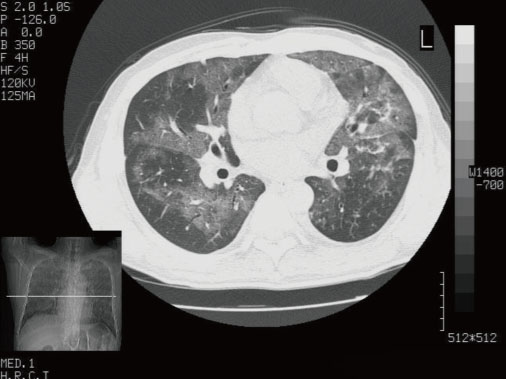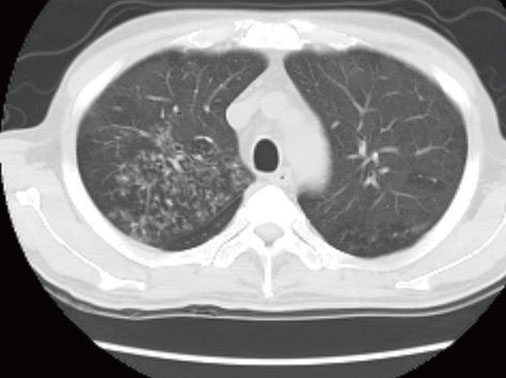Infect Chemother.
2010 Oct;42(5):319-322. 10.3947/ic.2010.42.5.319.
Pneumonia Caused by Corynebacterium macginleyi in HIV-infected Patient
- Affiliations
-
- 1The Division of Infectious Diseases, Department of Internal Medicine, The Yeungnam University of Korea, Daegu, Korea.
- 2The Division of Infectious Diseases, Department of Internal Medicine, The Catholic University of Korea, Seoul, Korea. sarang7529@catholic.ac.kr
- KMID: 1806898
- DOI: http://doi.org/10.3947/ic.2010.42.5.319
Abstract
- Corynebacterium macginleyi is usually isolated from the eye surfaces and causes ocular infections such as conjunctivitis, keratitis, and endophthalmitis. However, cases that describe C. macginleyi as the causative agent for significant and life-threatening infections in immunocompromised patients are increasingly reported. Herein we report the first documented case of C. macginleyi pneumonia in a human immunodeficiency virus (HIV) patient. A 42-year-old homosexual man with HIV infection was hospitalized with a 1-month history of fever and dry cough. Chest radiograph revealed ill defined ground glass opacities in both lung fields. Methenamine silver stain of bronchoalveolar lavage fluid was negative. He showed clinical improvement after treatment with trimethoprim/sulfamethoxazole and prednisolone for three weeks, and was discharged. One month later, he presented with dyspnea and more progressive pulmonary infiltrations. Bronchial washing fluid culture yielded >100,000 colonies/mL of C. macginleyi, and he was given a 14-day course of antibiotic therapy with vancomycin, after which the patient fully recovered. This case suggest the importance of not overlooking the significance of positive cultures for C. macginleyi obtained from representative clinical samples in patients with signs and symptoms of bacterial infection.
MeSH Terms
Figure
Reference
-
1. von Graevenitz A, Pünter-Streit V, Riegel P, Funke G. Coryneform bacteria in throat cultures of healthy individuals. J Clin Microbiol. 1998. 36:2087–2088.
Article2. Tarr PE, Stock F, Cooke RH, Fedorko DP, Lucey DR. Multidrug-resistant Corynebacterium striatum pneumonia in a heart transplant recipient. Transpl Infect Dis. 2003. 5:53–58.
Article3. Krish G, Beaver W, Sarubbi F, Verghese A. Corynebacterium xerosis as a cause of vertebral osteomyelitis. J Clin Microbiol. 1989. 27:2869–2870.
Article4. Belmares J, Detterline S, Pak JB, Parada JP. Corynebacterium endocarditis species-specific risk factors and outcomes. BMC Infect Dis. 2007. 7:4.5. Ferrer C, Ruiz-Moreno JM, Rodríguez A, Montero J, Alió JL. Postoperative Corynebacterium macginleyi endophthalmitis. J Cataract Refract Surg. 2004. 30:2441–2444.6. Funke G, Pagano-Niederer M, Bernauer W. Corynebacterium macginleyi has to date been isolated exclusively from conjunctival swabs. J Clin Microbiol. 1998. 36:3670–3673.
Article7. Giammanco GM, Di Marco V, Priolo I, Intrivici A, Grimont F, Grimont PA. Corynebacterium macginleyi isolation from conjunctival swab in Italy. Diagn Microbiol Infect Dis. 2002. 44:205–207.8. Joussen AM, Funke G, Joussen F, Herbertz G. Corynebacterium macginleyi: a conjunctiva specific pathogen. Br J Ophthalmol. 2000. 84:1420–1422.9. Davis JL, Fei M, Huang L. Respiratory infection complicating HIV infection. Curr Opin Infect Dis. 2008. 21:184–190.
Article10. McKenzie R, Travis WD, Dolan SA, Pittaluga S, Feuerstein IM, Shelhamer J, Yarchoan R, Masur H. The causes of death in patients with human immunodeficiency virus infection: a clinical and pathologic study with emphasis on the role of pulmonary diseases. Medicine (Baltimore). 1991. 70:326–343.
Article11. Dufour V, Cadranel J, Wislez M, Lavole A, Bergot E, Parrot A, Rufat P, Mayaud C. Changes in the pattern of respiratory diseases necessitating hospitalization of HIV-infected patients since the advent of highly active antiretroviral therapy. Lung. 2004. 182:331–341.
Article12. Murray JF, Mills J. Pulmonary infectious complications of human immunodeficiency virus infection. Part I. Am Rev Respir Dis. 1990. 141:1356–1372.
Article13. Young VM, Meyers WF, Moody MR, Schimpff SC. The emergence of coryneform bacteria as a cause of nosocomial infections in compromised hosts. Am J Med. 1981. 70:646–650.
Article14. Riegel P, Ruimy R, de Briel D, Prévost G, Jehl F, Christen R, Monteil H. Genomic diversity and phylogenetic relationships among lipid-requiring diphtheroids from humans and characterization of Corynebacterium macginleyi sp. nov. Int J Syst Bacteriol. 1995. 45:128–133.
Article15. Funke G, von Graevenitz A, Clarridge JE 3rd, Bernard KA. Clinical microbiology of coryneform bacteria. Clin Microbiol Rev. 1997. 10:125–159.
Article16. Villanueva JL, Domínguez A, Ríos MJ, Iglesias C. Corynebacterium macginleyi isolated from urine in a patient with a permanent bladder catheter. Scand J Infect Dis. 2002. 34:699–700.
Article17. Dobler G, Braveny I. Highly resistant Corynebacterium macginleyi as cause of intravenous catheter-related infection. Eur J Clin Microbiol Infect Dis. 2003. 22:72–73.
Article18. Pubill Sucarrat M, Martinez-Costa X, Sauca Subias G, Capdevila Morell JA. Corynebacterium macginleyi as an exceptional cause of endocarditis: a case report. An Med Interna. 2003. 20:654–655.19. Villamil-Cajoto I, Rodríguez-Otero L, García-Zabarte MA, Aguilera-Guirao A, García-Riestra C, Regueiro BJ, Villacián-Vicedo MJ. Septicemia caused by Corynebacterium macginleyi: a rare form of extraocular infection. Int J Infect Dis. 2008. 12:333–335.
Article20. Kwaszewska AK, Brewczyńska A, Szewczyk EM. Hydrophobicity and biofilm formation of lipophilic skin corynebacteria. Pol J Microbiol. 2006. 55:189–193.
- Full Text Links
- Actions
-
Cited
- CITED
-
- Close
- Share
- Similar articles
-
- Corneal Ulcer Caused by Corynebacterium macginleyi
- Esophago-Pleural Fistula with Multiple Esophageal Ulcers in Human Immunodeficiency Virus Infected Patient: A Case Report
- Common Infectious Diseases in HIV Infected Persons
- Comparison of Clinical Characteristics of Pneumocystis Carinii Pneumonia Between HIV Infected and Non-infected Persons
- Unmasking Granulomatous Pneumocystis jirovecii Pneumonia with Nodular Opacity in an HIV-Infected Patient after Initiation of Antiretroviral Therapy



